Also - See photos and comments from other
CES & ICCE,
Showest ,
CTIA,
SCTE |
| Get on our distribution list - click here |
|
|
|
CES Pre-Show & Press Events |
|
|
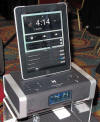 |
While last year saw a proliferation of iPhone accessories, this year we
find them made for your iPad, too. To the left we have the iA100
clock from iHome. It does the usual things that you'd expect.
Cost is $199. |
|
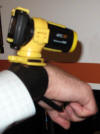 |
Used to be difficult to record full 1080p at 60fps in expensive camcorders.
Now you can wear one on your wrist. Shown here is the ATC9K from
Oregon Scientific. $299 for the basic unit. Add a GPS module
for geocoding your video for $70 more. |

 |
The iPhone and other smartphones are increasingly being used as a user
interface for various devices. Here we have a blood pressure
monitor from Withings that communicates to your phone to display and record your
measurements for $129. They have a bathroom scale, too, for $159. |
|
When are trekking across the wilderness and you just
have to update your Facebook page or send out a tweet
that you just got bit by a snake, now you can do so via
you smartphone and a link to satellite communications.
Spot Connect sells this small device for $169, and
various data plans (e.g. $29 for 100 messages, $50 for
500 msgs). |
 |
And, if your phone runs out of juice as you are trekking, you might want to
bring your charging iPhone case from Mophile. A 1500 mA hr unit is
$80 and a 2000mA hr unit is $100. It charges its own batteries via
a USB link. |
 |

 |
Here is another way to use your iPhone. Wear this Bodymedia FIT on
your arm wherever you go and know what your vitals are. The
armband communicates with Bluetooth (a non-Bluetooth unit also exists).
$250. |
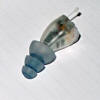 |
Everyone has heard of noise canceling headsets. Trouble is, if you
are hunter and you want to avoid ear damage from gun shot noise, yet
hear the footsteps of nearby deer, you can't use these nor earplugs.
In comes Etymotic with blast plugs that don't attenuate soft sounds, yet
muffles blast noise above 120 dB. These are used in the military,
but now you can own your own EB15 set for $495. |
|
Here is another iPhone used as a user interface - this
time with a iRadar detector from Cobra Electronics.
This $129 device uses Bluetooth and in addition to
telling you where the speed traps are, it verbally tells
you where the traffic cameras are. |
 |
Here is something else for your car. Plug this into your car's
diagnostic port and it delivers many of the features you may have heard
of from OnStar, only this is not OnStar. For example, if you get
into a crash, a message is sent to your love ones. Car needs oil?
Get email telling you so. This device comes from Mavizon Technologies
and costs about $300 (available Summer) |
 |
 |
Tremont Electric has taken a unique approach to charging up your portable
devices. Instead of using the sun, this attaches to your backpack
and uses your motion to charge things. It is called the nPower PEG
and it sells for $159 |
 |
As people get older we will continue to see devices and services like this
one from PomDevices. The Sonamba attempts to monitor seniors for
activities in the home to determine if they are doing the usual things.
If not, perhaps something is wrong, so it sends an alert. It also
lets the senior's children send reminders and photos remotely.
$549 for the device, $39/month for the service. |
|
Remember the iPhone 4's "death grip" issue, where
holding the phone a certain way seemed to attenuate the
signal? Metal iPhone cases can do the same, unless
you buy one from Element Case. The one shown here
comes out later in the year for something in the $100 -
$200 range. Rubber padding provides protection,
while milled aluminum is tough outside. |
 |
Sometimes companies try to make products that attempt to combine every type
of function one can think of. Here NZO (nzo.tv) has combined a
VOIP phone into your TV remote control. The Unitech remote costs
$65 and the "Microbox" STB costs $129. |
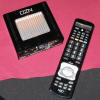 |
 |
XpanD is a leading maker of active glasses used in theaters and now for
consumers. This "Youniversal" set has a USB port for programming
(via iPhone), RF link and power. Available in April, but no price
yet. |
 |
LG is extending a number of themes from last year. A relatively new
item is a new remote control with acceleration sensors for moving a
mouse pointer on the TV's UI so you can select Apps and content.
The box is a Media Link "Upgrader" that plugs into an HDMI port to give
your non-LG TV an LG experience (apps and content). |
|
NetGear is always about speeds and feeds. Here we
have a WiFi repeater that you can discretely plug into
the wall to extend the reach of your base WiFi link. |
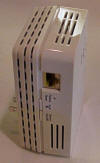 |
While introduced last year at IDF, Intel's "2nd generation" processor has
integrated graphics that take advantage of a more direct link to the
main CPU. Great for notebooks, but also for desktops, this nearly
1 billion transistor chip (held in photo) claims to beat at least half
the dedicated graphics cards out there. |
 |
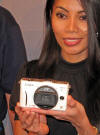 |
Consumer 3D continues evolving at CES. Here we have Panasonic's new
Lumix 3D camera. Actually, in a manner that is similar to their
consumer 3D camcorder, this 2D camera has a special lens for 3D on it.
3D photos can be viewed by putting the SD card from the camera into an
SD slot in Panasonic TVs and players. |
 |
Cisco introduced their consumer telepresence product called UMI (You-Me) a
little while ago. The camera sits atop a TV and works with a Cisco
box below it. Video quality is quite good if you are used to what
Skype provides. |
|
Every once in a while a new product is introduced that
breaks the old CE mold without being some kind of
gimmick. Such is the case for Pixel Optics and
their electronic glasses. By embedding a liquid
crystal layer on part of the lens, these glasses change
from regular near-sighted lenses to bifocal lenses.
So, the wearer doesn't get any distortion when viewing
distant objects, yet can read close objects when needed.
A touch of the frame (see photo) switches the lens mode.
Look closely at the photo and you see a small green
indicator light that tells you it is reading mode.
If you swipe the frame control, the glasses will
automatically switch to reading mode when you tilt your
head down. The frame is charged by an inductive
charger. Expect them in April at a cost of about
25 to 30% premium over regular bifocal glasses. |
 |
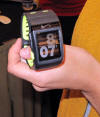 |
Now when Nike says "Just Do It", they can tell you what you just did.
Wear this SportWatch GPS and collect your vitals and track where you
ran. Tom Tom worked with Nike to make the mapping work.
Price will be $200-$300 in April. |
 |
Another blood pressure meter, this time from iHealth. This unit
communicates to your iPhone via the cradle (that also contrains the
pump). $100. |
|
This product is a set of speakers that can play music
from your iPhone or streams from Ethernet (WiFi or
cabled). Circuitry enhances the sound for you.
Bowers & Wilkins makes this Zeppelin Air AirPlay -
March, $600 |
 |
Look closely at the displays to the right. Samsung is showing how
OLED displays can be flexible. You can bend these displays in as
tight as a 1 cm radius. |
 |
 |
For iPhone (and other smartphone) users that miss that old handset feel,
now you can plug in one of these Moshi Moshi (means 'hello' in Japan)
handsets from Native Union for $30. They also have more stylish
executive type handsets that are Bluetooth linked so you appear to have
a cordless phone - $100. |
 |
We close out the pre-CES show with the Steam Convection Oven from
Thermador. Ever warm up food and have it come out dry? Steam
heating solves your problems. Some professional cooks use this
trick and now you, the consumer can too for $3K. |
|
CES - Day 1 |
|
How would you like to have a phone that lets you watch
3D movies without having to wear glasses? The
technology is well in hand, so to speak (pun intended).
The phone to the right is a prototype from LG, so you
can't buy it, yet... |

|
Tired of those up/down/left/right keys on your remote? Panasonic showed off
a remote that you wave in the air to point to things on your TV in
3D. Can't buy this, either, because it, to is a prototype. |
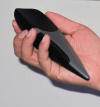 |
 |
Here is the long rumored consumer 3D camcorder from Sony (HDR-TD10).
Relatively sophisticated video electronics and optics, including
autostereoscopic monitor. Available in April for $1.5K. |
 |
Aside from the stylish looks, this Samsung monitor automatically converts
2D images into 3D, real time. We've go opinions about this type of
technology, but will save them for later. The model number is
TA950, but no price yet. |
Speaking of Samsung, here we have their CEO (left) and
Adobe's CEO (right) announcing Flash and Air for
Samsung's TVs. Samsung has a big App Store,
messaging, streaming media, etc. Sort of like a 75
inch iPhone, only with Flash.
|

|
OK, what is this? When you wave your hand through the red beams you
modulate the music that is playing. It comes from Beamz
Interactive for $199. Can't do it justice here - you'll have to
hear it yourself. |
 |
 |
GM showed off their en-V electric vehicle. It is running at the
Shanghai Worlds Fair, but you can't buy it. Believe it or not, it only
has 2 wheels. Runs 40 miles on a charge. |
 |
Gear4 has their Unity Remote that replaces all of your remotes with your
iPhone. Place the IR blaster unit in the room and download the App
and control everything. Just $99. |
|
Another quiz - what is this? Mindscape spent 15 minutes
explaining it to me and I still not sure. The
Karotz unit in the middle does radio, RSS feeds, MP3,
webcam, alarm, voice chat, information services, games
and more (while wiggling its ears). The small
units have RF tags that activate the Karotz. Buy
it in April for $179 |
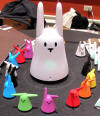 |
Sphero has a ball that lights up different colors and rolls around on your
commands from your iPhone or iPad. Pure amusement. Sort of
like the 2011 edition of a Pet Rock. Available in time for next
holiday season for under $100. |
 |
 |
I've a friend that is about to sail around the world. If someone goes
overboard, better have one of these Scout PS32 units from FLIR to pick
out the person in the waves. FLIR Systems has shown larger units
in the past. This new one is just $2K.
|
 |
The Anti Sleep Pilot looks for how long you
are driving, lighting and time of day to determine if you should pull
over and rest. If so, it flashes red and sounds an alarm.
You can also set it to "test" your response. Last
product I saw tonight and I was too tired to ask the price. |
|
|
|
This was taken at 3PM on the first day of CES. |
 |
|
CES - Day 2 |
|
Remember the scene in Star Wars when R2D2 projected a 3D
image of the princess? Here is the real deal from
Burton that they call Aerial 3D. They had private
viewings of this display last year, but no photos
were allowed. This year's version is higher quality.
No glasses needed and it is like viewing an actual full
360 degree 3D object. Works by ionizing the
gasses. |
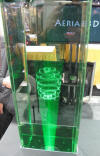 |
Now you can view 3D without glasses on your iPhone. Download the free
3DeeCentral App and attach the 3DeeSlide to your iPhone and watch 3D
now. For a very limited time the 3DeeSlide is free. |
 |
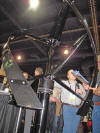 |
Put a real wind-power generator on your roof. This one from Urban
Green Energy puts out a peak of 600 Watts and costs about $3800. |
 |
Goal0 (Goal Zero) makes a series of solar power panels and battery units
that range in price from about $360 to $2.2K. Great for campers or
emergencies. Output is to USB, 12V or full AC. |
|
Victorinox introduced an update to their USB drive
knife. Their Presentation Master contains (true to
form) knife, file, scissors, 64GB USB encrypted data
drive, fingerprint reader, Laser pointer, and Bluetooth
link for $300. See it on their website in a few
weeks. |
 |
BAC Track is making money off the high costs and risks of drving drunk with
a line of consumer breathilizer testers. This middle of the line
unit, B70, costs $70 and is FDA approved. It can measure up to
0.4% alcohol (5X legal limit). |
 |
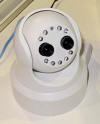 |
3D is catching on everywhere.
Mega Systems Technologies sells a number of gadgets, including this new 3D
IP Camera. It converts what it sees to red-blue anaglyph for
viewing on regular monitors. $120. |
 |
Here we have a new 3D monocular. Look through these and the image looks like it
is in 3D. Previous units only allowed a 2D image, making it
difficult to figure out where things were :-) |
|
|
|
|
|
|
CES - Day 3 |
|
For the person that claims to miss when life was simple
and not so plastic, the Impecca KBB500 keyboard.
$80-90 for cabled version. Wireless slightly more. |
 |
Fujifilm has come out with their 2nd generation 3D camera/cam. This
one has a number of new tricks, too many to list here, so check it out.
It is the model W3 and the price is still $500 - only now they have lots
of competition from other companies, so we'll see if the price holds. |
 |
 |
There were also many 3D camcorders this year. This one from JVC
sticks out (good or bad) because it actually shoots in 2D and
electronically converts to 3D (similar trick to some 3D TV).
DIGDIA feels that 2D to 3D real time conversion is a gimmick. |
 |
Since we are on the subject of 3D, some vendors were showing off something
they called "3D Sound". Remember when High Definition was new?
Vendors started to call just about everything "HD". So, it is no
surprise to see several "3D Sound" signs. What is "3D sound"?
Generally it refers to sound bars or other fancy speaker systems. |
|
Short day due to meetings, so not so many photos today |
|
|
|
CES - Day 4 |
|
Ford's big announcement during CES was their Ford Focus Electric car.
This is a 100% electric car. It has a range of 50 to 80 miles from
a 3 hour charge. The charger is shown on the right. It uses
240 volts AC and Ford is working with Best Buy Geek Squad to work out
home installations. The charger has Microsoft software that is
used to pick the best and cheapest time to charge the car (e.g. late
night instead of peak day hours). Batteries are internally cooled
to optimize charging. They are designed for 10 years and 150K
miles.
|
 |
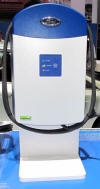
|

|
EZSkaters.net has a different approach to electric
travel. Add electric motors to your skate board. Speed is
controlled by a handheld unit. They say you can get to speeds exceeding
20 MPH. Does not come with brakes.
|

|
Taiwan San Tyau sells eTape. Booth person said
tape measures are one of the most common household tools. This
eTape reads your measurement to within 16th of an inch digitally.
It has a memory button, so you don't have to write it down. $30.
|
|
Celluon's Magic Cube is a very small device that
projects a keyboard onto the table. You type on
this virtual keyboard, or you can move a finger around
as if you were using a mouse pad. It actually
works, though you might need some adjustment.
Battery lasts 3 hours. $170. |
 |
Today's quiz - what is this? It is a set of speakers for your iPod.
It is made by Amethyst S&D. They make several unusual speakers.
The model shown is the X-1 and it sells for about $63. |

|
 |
Seems that every year someone introduces a wearable display. We
spotted two this year. This one was seen in the White Box Robotics
booth. They said a price will be announced soon. You will
have to guess what type of 3D video this guy is smiling about. |
 |
All kinds of 3D stuff came out this year (see our report on
3D Entertainment so learn more). ViewSonic seems to have
jumped in with both feet. They showed 3D products in seven
different product categories. Here we see their 3DVH8 3D 1080
camcorder. The monitor displays in 3D without glasses. Q2
intro - $249. |
|
Pioneer was showing a prototype heads up display (HUD).
The image is projected onto the windshield with a
laser-based display system. The display, in this
case, mimics a navigation map. |
 |
Shenzhen Anxin hopes to sell you their "Image Attendance Checker".
One walks up to this device and it tells you if it recognized you.
Of course, you have to somehow be in the database already. $190. |
 |
 |
As 3D filters into the market, some people might want to look fashionable
while enjoying it. Why not whip out your Nike, Lacoste, Nautica or
CK Calvin 3D glasses? All of these will work in RealD theaters, as
well as certain3DTVs (e.g. LG). Prices range from $40 to $200.
The Mfr. is Marchon3D |
 |
Many CES booths put bowls of candy out in an attempt to attract people to
visit their booth. Some conferences go as far as serving
cappuccino or even real
martinis. During the last hour of CES, we found one booth that had
what you see to the left. Must have run out of the good stuff. |
|
ICCE (International Conference on Consumer
Electronics) |
|
If you are not familiar with ICCE, think of it as the
R&D counterpart to the Marketing done at CES. |
|
Here we have a few of the slides presented by
Microsoft's Dr. Gary Sullivan. Gary has been
involved in video coding and related topics for years.
These three slides show 1) a brief timeline of video
compression standards, 2) a current effort for video
over HTTP called DASH (typo in slide) and 3) a new
effort to upstage H.264 called High Efficiency Video
Coding (HEVC). Several proposals for HEVC have
already achieved 2X performance over H.264. |
   |
 |
Every year the IEEE Consumer Electronics Society awards the IEEE
Masaru Ibuka award to a member for outstanding contributions to consumer
electronics. This year's award goes to Joan Mitchell. Joan
is now retired, but was she has a long list of accomplishments related
to a topic any digital camera owner should care about - JPG. Most
of her work was done while she was in IBM. She was at the very
start of the formation of JPG and has contributed so multiple and
related topics, including MPEG, which is the foundation for the way you
probably watch TV. |
A brand new topic for ICCE this year is the Smart Grid.
The U.S. could save over $100 Billion if it only used
electricity in smarter ways. This topic is
catching fire, and if you haven't heard of it yet, you
will. The slides to the right were presented by
Paul De Martini, VP and CTO of Cisco's Smart Grid
effort.,
|
  |
  |
David Broberg is a key guy in CableLabs involved in helping to make 3D look
good on your TV. His talk pointed out some issues that people
should consider when creating 3D content for TV. The first slide is an
overview of HIT (Horizontal Image Translation), which is used to adjust
apparent depth of objects. HIT can make an object look like it is
closer or farther away, but it can also be abused. The second
slide summarizes his recommendations. Among other things, David
points out that shiny bezels often found on today's 3D TV set actually
work against good 3D viewing. |

